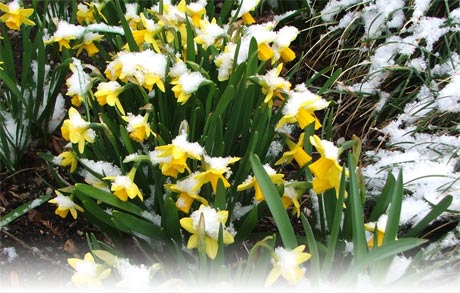
If we don’t get an inch of rain a week, I turn on the water for a good, deep soak. This is important going into the Winter because when the ground freezes hard, plants cannot absorb any water into their systems. As the Winter winds blow, moisture is whipped out of the plants and there is no way for them to replace it. This is the cause for Winter-burn and consequently, death, if the freeze goes on long enough and the plants were already dry. Fall watering “plumps them up” and helps to protect them against Winter-burn. When the ground finally does freeze, though, don’t forget to turn off your outdoor faucets from the inside and drain them so your pipes don’t freeze! In addition, bring in your hoses. Ceramic pots can freeze, swell and crack, too—unless you have the frost-proof kinds--so don’t forget to store or cover them.
Be sure to gently knock any snow off your flexible plants, such as Boxwoods and Waxmyrtles, to prevent breakage. Do not try to knock off ice (or pour hot water on your plants to melt it!). Let it melt naturally and fall on its own. The stems are extremely brittle when covered with ice. What I learned from the last two Winter’s heavy, heavy snows and ice: Let Nature take its course. I tried to knock the snow off early on, but eventually I just let the snow pile up and enclose the plants. Then I left them alone. I made this decision after I tried to get proactive and knock some heavy snow off a big Boxwood branch—the branch had iced underneath the snow and the whole thing cracked off when I shook it too hard. Lesson learned--and I went inside.
You can also use an anti-desiccant (an anti-drying agent), such as Wilt-Pruf, on your tender broadleaf evergreens if you wish. I put it on my Camellias and other plants in areas exposed to Winter sun and wind. The sun can burn plants after a particularly cold night, too. Another way to protect your most tender plants is to wrap them in cotton burlap.
If you decorate the indoors of your home for the holidays, now is a good time to do some pruning on your evergreens. You can use the cuttings for your decorating. Just make sure to step back frequently to make sure your pruning is uniform!
You can add mulch now, too, if it is needed. Your mulch should measure no more than two-three inches deep—this includes the mulch you added earlier this year. Mulch that is too deep stifles plant growth, so go easy. No fertilizing on your shrubbery should take place until late Winter–early Spring.
Let your houseplants rest while indoors for the Winter. I give them as much light as I can, and I only water them when they begin to look like they need it—which isn’t very often. I don’t fertilize at all over the Winter, either, because I don’t want them to grow until the sun gets strong again in late Winter. I begin feeding them again around March 1st with a water-soluble fertilizer like Miracle-Gro or Peter’s.
I never leave liquid garden chemicals out in the shed where they can freeze. It can ruin them. I put them in my utility room, on a high shelf, out of the sun. They should be in a cool, dry, frost-free storage spot. The main thing is to safely store them out of the reach of children and pets, and others who may not know what they are grabbing. Always read the labels (you should be doing this, anyway, for everyone’s safety)—they will always tell you about storage. And check those expiration dates—safely and properly discard them if out of date.
Next story >Bloom of Warmth



